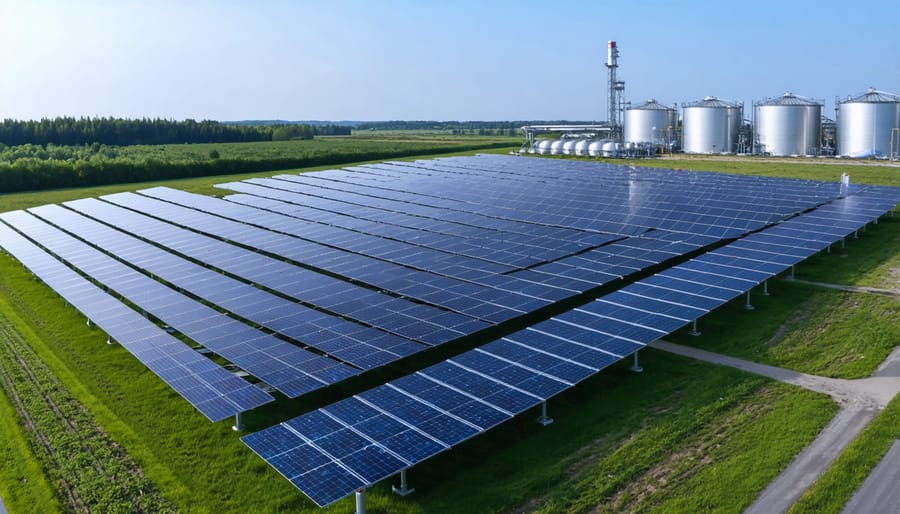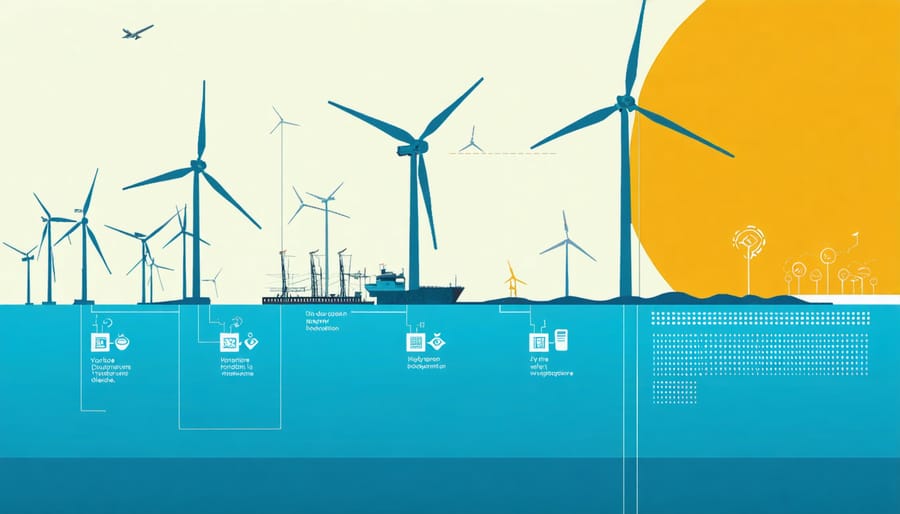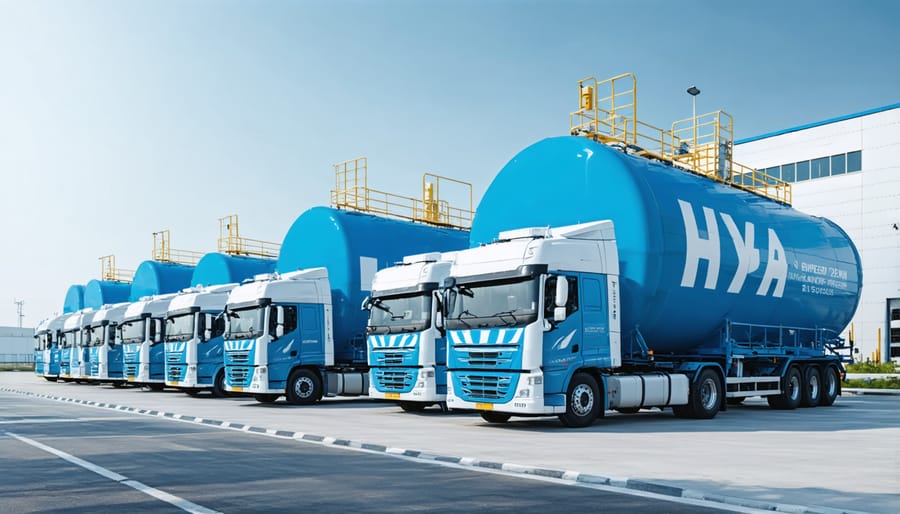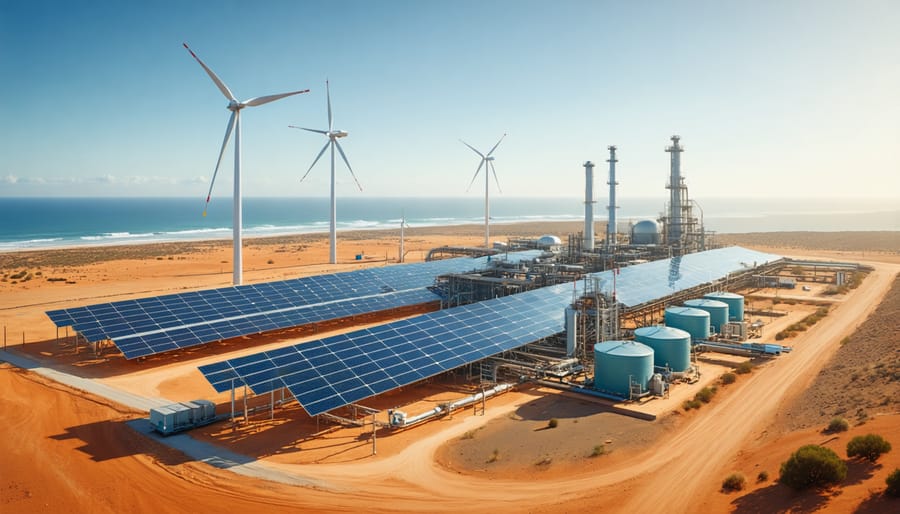In Australia’s race toward a sustainable future, clean energy technologies like solar and wind power are revolutionizing hydrogen production, offering a pathway to true zero-emission energy. Beyond traditional hydropower, these non-hydro renewables are rapidly transforming our energy landscape, with Australia’s vast solar resources and windswept coastlines providing an unparalleled opportunity for clean hydrogen generation.
The integration of solar farms and wind turbines into hydrogen production facilities has already demonstrated remarkable success, achieving up to 70% greater efficiency compared to conventional methods. From the sun-drenched outback to coastal wind farms, these technologies are proving that sustainable hydrogen production isn’t just environmentally responsible – it’s economically viable.
As global demand for clean hydrogen surges, Australia stands at the forefront of innovation, leveraging its natural advantages to pioneer new approaches in renewable energy integration. This shift towards non-hydro renewables isn’t just reshaping our energy sector; it’s creating a blueprint for sustainable industrial development that other nations are eager to follow.
The future of clean energy lies in harnessing these renewable resources effectively, and Australia’s commitment to non-hydro renewable hydrogen production is setting new standards for environmental stewardship and economic growth.
The Power Duo: Solar and Wind in Green Hydrogen Production
Solar-Powered Electrolysis
Solar-powered electrolysis represents a groundbreaking approach to clean hydrogen production, particularly relevant in sun-rich Australia. This process harnesses the abundant solar energy through photovoltaic panels to power electrolysers, which split water molecules into hydrogen and oxygen without producing harmful emissions.
In recent years, Australia has emerged as a pioneer in solar-powered hydrogen production, with several innovative projects demonstrating its viability. The Western Australian Renewable Hydrogen Project, for instance, combines a 1.5MW solar array with electrolysers to produce clean hydrogen for local industry use.
The efficiency of solar-powered electrolysis has improved dramatically, with modern systems achieving conversion rates of up to 30% from solar to hydrogen energy. This advancement has made the technology increasingly attractive for both industrial applications and green energy storage solutions.
What makes this approach particularly appealing is its scalability and minimal environmental impact. During peak sunlight hours, excess solar energy can be directed to hydrogen production, effectively storing energy for later use. This solution addresses one of renewable energy’s biggest challenges: intermittency.
Australian researchers are currently developing enhanced electrode materials and system designs to further improve efficiency and reduce costs. These innovations, coupled with Australia’s exceptional solar resources, position solar-powered electrolysis as a cornerstone of our renewable hydrogen future.

Wind Energy’s Role in Hydrogen Generation
Wind energy plays a pivotal role in Australia’s growing hydrogen economy, offering a clean and sustainable pathway for hydrogen production through electrolysis. When wind turbines generate electricity, this renewable power can be used to split water molecules into hydrogen and oxygen, creating what’s known as “green hydrogen” – a zero-emission fuel that’s gaining tremendous interest across the country.
The synergy between wind power and hydrogen production is particularly compelling in regions like Western Australia and South Australia, where strong coastal winds provide consistent renewable energy resources. These areas are becoming hotspots for integrated wind-to-hydrogen projects, with several facilities already operational and many more in development.
A standout example is the Western Australian Renewable Hydrogen Project, which harnesses the region’s world-class wind resources to produce green hydrogen for both domestic use and export. The project demonstrates how wind energy can support Australia’s ambition to become a major player in the global hydrogen market.
The intermittent nature of wind power is actually well-suited to hydrogen production, as excess wind energy during off-peak periods can be used to generate and store hydrogen, effectively acting as a form of energy storage. This stored hydrogen can then be used when needed, whether for power generation, transport fuel, or industrial processes.
Looking ahead, the combination of Australia’s abundant wind resources and growing hydrogen infrastructure positions the country to lead in clean hydrogen production, creating new opportunities for regional development and sustainable energy exports.

Australian Success Stories in Renewable Hydrogen
Major Projects and Initiatives
Australia is leading the charge in innovative non-hydro renewable hydrogen projects, with several groundbreaking facilities already operational and more in development. The Western Green Energy Hub in Western Australia stands as a testament to this progress, combining massive solar and wind installations to power hydrogen production across 15,000 square kilometers.
The Port of Newcastle’s hydrogen hub showcases how industrial sites can transform into clean energy powerhouses, integrating revolutionary storage solutions with renewable hydrogen production. This project alone aims to produce over 150 tonnes of green hydrogen daily, solely using wind and solar power.
In Queensland, the Pacific Solar Hydrogen project represents another milestone, utilizing 3.6GW of solar panels to generate renewable hydrogen for both domestic use and export to Asian markets. This initiative demonstrates how Australia can leverage its abundant sunshine to become a global hydrogen powerhouse.
The Hydrogen Energy Supply Chain (HESC) project in Victoria combines solar power with advanced electrolysis technology, proving that large-scale renewable hydrogen production is commercially viable. This pioneering facility has already begun shipping clean hydrogen to Japan, establishing Australia as a trusted supplier in the emerging global hydrogen economy.
Looking ahead, the Asian Renewable Energy Hub in the Pilbara region promises to be a game-changer, with plans to harness 26GW of wind and solar power for green hydrogen production. These projects aren’t just creating clean energy – they’re generating jobs, boosting regional economies, and positioning Australia at the forefront of the renewable hydrogen revolution.
Economic and Environmental Benefits
Non-hydro renewables deliver substantial economic benefits while significantly reducing environmental impact. In Australia, the transition to renewable energy sources has created thousands of new jobs, particularly in regional areas where solar and wind farms are predominantly located. These projects not only generate clean energy but also provide steady income streams for farmers who lease their land for renewable installations.
The environmental advantages are equally compelling. Unlike fossil fuels, non-hydro renewables produce minimal greenhouse gas emissions during operation. A typical wind farm in Australia can offset approximately 750,000 tonnes of carbon dioxide annually – equivalent to taking 160,000 cars off the road. Solar installations similarly reduce carbon footprints while requiring minimal water usage compared to traditional power generation methods.
The economic ripple effects extend beyond direct employment. Local businesses benefit from increased activity during construction phases, while ongoing maintenance creates sustained economic opportunities. Communities hosting renewable projects often receive community benefit funds, supporting local infrastructure and social programs.
From an investment perspective, non-hydro renewables increasingly offer better returns than conventional energy sources. As technology costs continue to fall, the business case becomes more compelling. Many Australian businesses are now choosing to install their own renewable energy systems, reducing operational costs while meeting sustainability goals.
The environmental benefits compound over time. Renewable energy projects help preserve biodiversity by minimizing land degradation and reducing air pollution. They also contribute to water conservation, as solar and wind power require virtually no water for operation, unlike traditional power plants that need substantial amounts for cooling.
This combination of economic growth and environmental protection makes non-hydro renewables a cornerstone of Australia’s sustainable future, delivering both immediate and long-term benefits to communities and ecosystems alike.
Overcoming Technical Challenges
Storage and Distribution Solutions
As Australia’s renewable energy sector grows, innovative energy storage breakthroughs are revolutionizing how we manage and distribute clean power. Advanced battery technologies, including grid-scale lithium-ion installations and emerging flow battery systems, are becoming increasingly prevalent across the country. These solutions are particularly vital in remote communities, where they’re helping to create reliable microgrids powered by solar and wind energy.
The development of hydrogen storage infrastructure is showing promising results, with several pilot projects demonstrating how excess renewable energy can be converted to hydrogen for long-term storage. This approach is proving especially valuable in South Australia’s renewable energy zones, where wind and solar generation often exceeds immediate demand.
Smart grid technologies are transforming distribution networks, enabling real-time load balancing and automated response to supply fluctuations. These systems are particularly effective in urban areas, where they’re helping to optimize energy flow and reduce wastage. Virtual power plants (VPPs) are emerging as a game-changing solution, connecting thousands of residential solar and battery systems to create a coordinated network that can respond to peak demand periods.
In regional areas, innovative thermal storage solutions are gaining traction, using materials like molten salt to store energy from solar thermal plants. These developments are backed by substantial investment in transmission infrastructure, ensuring that renewable energy can be efficiently distributed to where it’s needed most.

Cost-Effective Implementation
Making renewable hydrogen production economically viable requires a multi-faceted approach that combines technological innovation with smart business strategies. One of the most effective methods is to integrate renewable hydrogen production with existing solar and wind farms, leveraging the infrastructure and reducing overall costs.
Australian companies are leading the way with innovative cost-reduction strategies. For instance, several facilities in Western Australia are utilizing excess solar power during peak production hours to generate hydrogen, effectively turning what would be curtailed energy into valuable fuel. This approach not only maximizes resource efficiency but also creates additional revenue streams.
Scale is another crucial factor in cost reduction. As production volumes increase, the cost per unit decreases significantly. The Western Green Energy Hub, planned for Western Australia, demonstrates how large-scale operations can make renewable hydrogen more commercially competitive.
Smart financing models are also emerging as key enablers. Green bonds and government incentives are helping to offset initial capital costs, while power purchase agreements (PPAs) provide long-term price stability. Many Australian projects are successfully utilizing these tools to make their operations financially sustainable.
Energy storage solutions play a vital role in cost optimization. By incorporating battery systems and advanced hydrogen storage technologies, facilities can better manage production schedules and respond to market demands, ultimately improving their economic viability.
The integration of artificial intelligence and automation is further driving down operational costs, with smart systems optimizing production processes and reducing maintenance requirements.
Future Prospects and Opportunities
The future of non-hydro renewables in Australia looks increasingly promising, with several emerging technologies poised to transform our energy landscape. Recent green energy innovations are opening up exciting possibilities for more efficient and cost-effective renewable energy solutions.
Floating solar farms are gaining traction as a space-efficient alternative, particularly in regions where land availability is limited. These innovative installations can be deployed on reservoirs and water bodies, simultaneously generating power and reducing water evaporation. Australia’s abundant coastline and inland water resources make this technology particularly appealing for our context.
Artificial Intelligence and machine learning are revolutionizing how we manage renewable energy systems. Smart grids powered by AI can better predict energy demand, optimize storage solutions, and balance power distribution more effectively. This technological integration is expected to significantly improve the reliability and efficiency of renewable energy systems across the country.
Hybrid systems combining different renewable sources are emerging as a game-changing solution. By integrating solar, wind, and battery storage, these systems can provide more consistent power output throughout the day and night. Several pilot projects in regional Australia are already demonstrating the viability of this approach.
The development of green hydrogen production facilities powered by renewables presents another exciting frontier. Australia’s abundant solar and wind resources position us perfectly to become a global leader in green hydrogen exports, with several major projects already in development across the country.
Community-scale renewable energy projects are also set to expand, with innovative financing models making clean energy more accessible to regional communities. These initiatives not only promote energy independence but also create local jobs and economic opportunities.
As technology costs continue to decline and efficiency improves, we’re likely to see accelerated adoption of these solutions across both urban and rural Australia. The future of non-hydro renewables isn’t just about power generation – it’s about creating a more sustainable and resilient energy ecosystem for generations to come.
The transition to renewable hydrogen represents a crucial step in Australia’s journey towards a sustainable energy future. Throughout this article, we’ve explored how non-hydro renewables, particularly solar and wind power, are revolutionizing hydrogen production and creating new opportunities for clean energy development.
By harnessing our abundant solar and wind resources, Australia is uniquely positioned to become a global leader in renewable hydrogen production. The successful projects we’ve examined demonstrate that the technology is not just viable but increasingly cost-competitive with traditional energy sources.
The benefits extend far beyond environmental considerations. From creating new jobs in regional communities to establishing Australia as a clean energy powerhouse, renewable hydrogen offers tremendous economic potential. The growing international demand for clean hydrogen presents an unprecedented opportunity for our nation to lead the way in sustainable energy exports.
However, realizing this potential requires collective action. Whether you’re an industry professional, policymaker, or concerned citizen, there are ways to support this transition. Consider advocating for renewable hydrogen initiatives in your community, investing in clean energy projects, or simply staying informed about technological developments in this rapidly evolving field.
The path to a sustainable future is clear, and renewable hydrogen powered by solar and wind energy is a crucial part of that journey. Together, we can build a cleaner, more prosperous Australia that leads the world in renewable energy innovation.

